If you are going to make a trip to Vietnam, then partaking in top New Year cultural festivals in Northern Vietnam is a meaningful and unforgettable activity. It is worth noting that festivals play an essential part in the life of the locals. Hence, attending festivals and visiting temples and pagodas after Tet holiday have become their unchanged traditions. While the S-shaped country has about 9,000 local and national festivals, the North of Vietnam is home to a huge number of traditional and cultural ones. In general, most of them are held in spring, meaning in the first month of the Lunar New Year. If you are a culture lover, then keep reading to know some notable festivals in the northern region of the country.
Huong (Perfume) Pagoda Festival
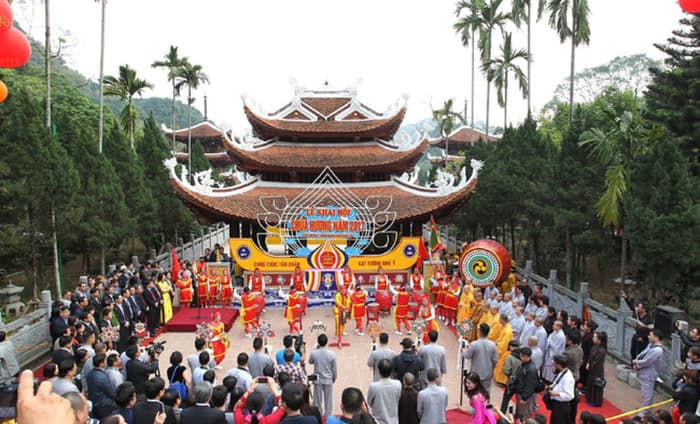
- Time: From 1st to 3rd lunar month
- Address: My Duc District, Hanoi
- Purpose: Worship Buddha and pilgrimage
- Ceremonies: Zen ceremony and incense offerings
- Entertaining activities: mountain climbing, boat cruising, and sightseeing
Huong Pagoda Festival is considered the biggest and longest event in the Northern Vietnam, which begins on the 6th day of the 1st lunar month and even lasts for 3 months annually. During that time, this large-scale event attracted a huge number of both visitors and pilgrims alike to attend. While tourists get involved in the festival for praying and sightseeing, pilgrims soak up the ceremonial rituals, such as incense offering and Zen ceremony. Besides, a chance to taste 3 famous delicacies, including bamboo shoot, grinding roots and Sang vegetables, is also what you can get during the festive time. Not easy to ignore all, right?
Yen Tu Spring Festival
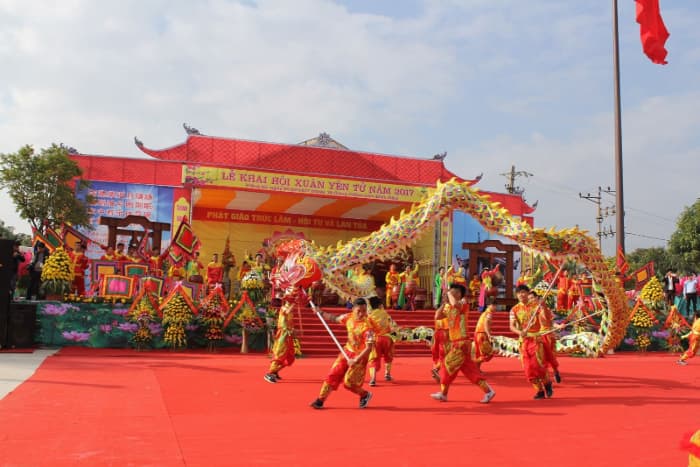
- Time: From 1st to 3rd lunar month
- Address: Yen Tu Mountain, Uong Bi District, Quang Ninh Province
- Purpose: Worship Buddha and pilgrimage
- Ceremonies: Traditional rituals
- Entertaining activities: Mountain climbing, playing folk games, and seeing art performances.
Another prominent festival in Vietnam is Yen Tu spring festival, which is annually held from the 10th day of the 1st lunar month to the end of the 3rd month. In fact, the mountainous region of Yen Tu has been a center of Buddhism for centuries. What makes the region outstanding and impressive is its mountainous beauty mingling with the solemn quietness of its pagodas and shrines. During the festive season, pilgrims and visitors gather here to pray for good luck, show their belief and aspiration, get rid of sorrows and sadness, make a pilgrimage to Buddha, and get lost in nature.
Giong (Soc Son) Temple Festival
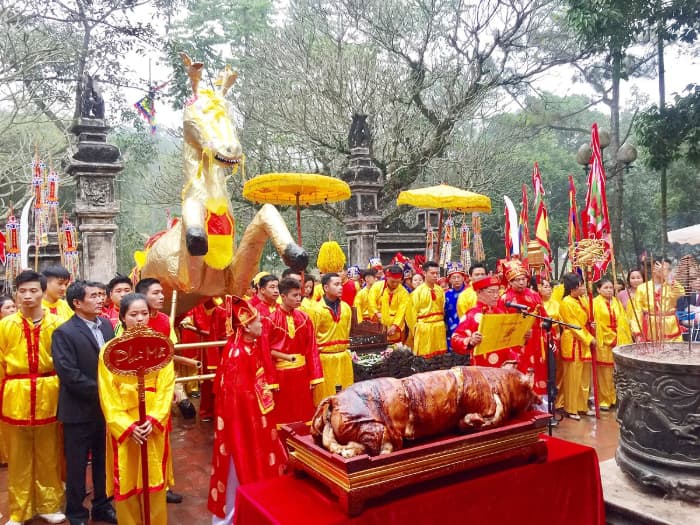
- Time: From the 6th day to 8th day of the first lunar month
- Address: Soc Son Temple, Phu Linh Commune, Soc Son District, Hanoi
- Purpose: Commemorate Saint Giong and wish for abundant harvests and a prosperous life
- Ceremonies: Processions, cleaning Giong’s statue, and incense offerings
- Entertaining activities: Enjoying traditional singing and playing folk games.
Legend has it that Soc Son District was where Saint Giong took the last rest before ascending to the heaven. Lasting for 3 days, the festival catches much attention from both locals and visitors. At midnight of the 6th day, the statue of Saint Giong is well cleaned with the support from villagers and pilgrims. During the 7th and 8th day, there are the 2 main rituals, including the processions of bamboo flowers to Soc temple as well as the reproduction of slaying the invaders’ general.
Ba Chua Kho Temple Festival
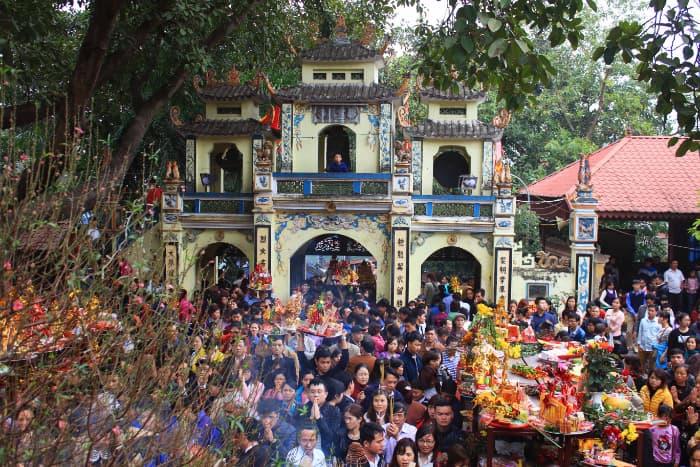
- Time: The 14th day of the first lunar month
- Address: Co Me Village, Vu Ninh Commune, Bac Ninh Province
- Purpose: Worship Ba Chua Kho and 4 primary gods (namely Thien phu, Dia phu, Thuy phu, and Nhac phu).
- Ceremonies: Incense offering, borrowing money from her (for symbolizing only) to pray for good luck and property.
Taking place on the 14th day of the first lunar month, Ba Chua Kho temple festival annually attracts lots of the tourists, including business people, to worship and pray for good fortune. They participate in the ceremony to “borrow” money from Ba Chua Kho with the hope for a smooth year and prosperity. Of course, each request must be written in a paper, known as “So” (Sớ), about why they borrow, how much, what to do, and even promise when they will pay it back.
Bai Dinh Pagoda Festival
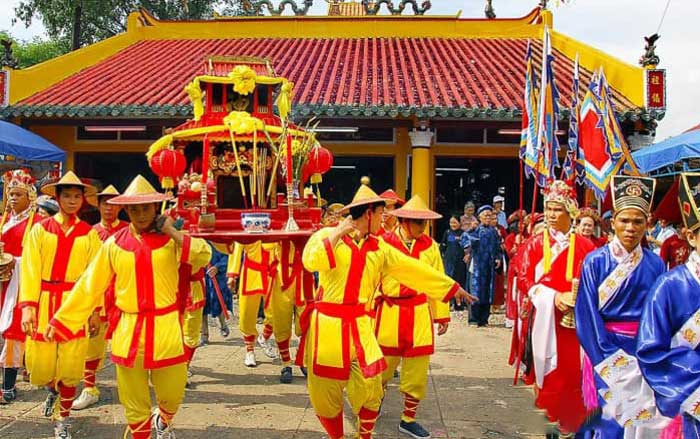
- Time: From the 1st to 3rd lunar month
- Address: Sinh Duoc Village, Gia Sinh Commune, Gia Vien District, Ninh Binh Province
- Purpose: Express beliefs on Buddhism and Confucianism, worship the Gods and Buddha, as well as honoring national heroes.
- Ceremonies: Incense offerings, giving oblations to God Cao Son, commemorating Saint Nguyen Minh Thong, and attending Goddess Thuong Ngan’s audience
- Entertaining activities: Sightseeing, playing folk games, and watching traditional music performances
Bai Dinh pagoda festival takes places on the 6th day of the first lunar month every year, and then lasts for 3 months with the aim of helping locals and visitors enjoy much more time in the festive atmosphere. While a visit to the pagoda at that time brings tourists a great opportunity to experience the festival’s meaningful ceremonies and activities, they also feast their eyes on the magnificent scenes of mountains and caves, learn more about Vietnamese culture, play folk games, along with enjoying performances of Cheo, Ca Tru and Xam singing.
Lim Festival
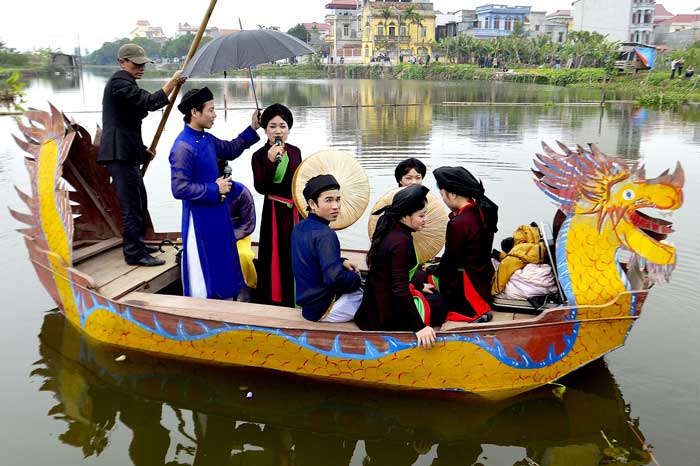
- Time: The 12th and 13th day of the first lunar month
- Address: Lim Village, Tien Du District, Bac Ninh Province
- Purpose: Worship Ba Mu and promote the tradition of Quan Ho folk songs
- Ceremonies: Processions and worshiping rites
- Entertaining activities: Weaving competitions, Quan Ho singing, traditional games
As one of the important cultural festivals in Vietnam, Lim festival is celebrated to enhance and promote Quan Ho folk songs – one of the country’s intangible cultural heritages. After the Tet holiday, about 12th and 13th day of the first lunar month, thousands of visitors and pilgrims visit Lim Village to enjoy attractive dialogues performances between “Lien anh” (Male singers) and “Lien chi” (Female singers). During the performance, these singers should have not only quick reaction but also a deep understanding on traditional tunes, in addition to history and culture of these songs. As normal, the indispensable part of the festival is ritual stages, which include processions and worshipping ceremonies.
In brief, New Year cultural festivals in Northern Vietnam aim to bring the locals and travelers a great time of relaxing after a long year of working and studying. Furthermore, those events also play a significant role in their spiritual life, in which they may worship for luck, prosperity and health. While immersing in the festivals, tourists can both learn more about Vietnamese culture and find themselves truly excited with many games and activities. However, remember that such festive areas are very noisy and even crowded. So, be mindful and cautious of any unexpected happening.



